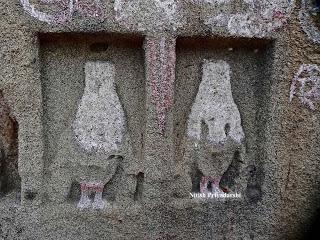 Caves of Barabar hills near Gaya.
Caves of Barabar hills near Gaya.A visit to Barabar caves near Gaya in Bihar, which is an isolated location away from the mainstream, makes one imagine the activities at the place in ancient times, as the abode of the mendicants. Not much seems to have changed in the timeline of history, if one spends some time to meditate inside the caves which still bear the Mauryan Polish in a way as if it had been polished just yesterday. Several inscriptions are to be seen on the caves. The Hills have always remained mysterious and convey a spiritual reverberation.
The Hills were first excavated for the Ajivikas during the reign of Asoka and were occupied during the following centuries by different groups of sages and mendicants.
I visited the Hills at Barabar in August, 2016 during my way back to Ranchi from Patna. About 40 kilometers to the north of Gaya in Bihar, near Belaganj, there are several groups of granite hills, called Kauwa-Dol, Barabar, Nagarjuni and Dharawat. All of these possess several remains of the ancient times. The caves in the Barabar hills are usually known as the Sapt-griha or sat-ghara.
A cave is a naturally occurring hollow area inside the earth or in the hills. Most caves are formed by some type of erosional process and also man made. The most notable exception is hollow lava tubes such as those in Hawaii. The formation of caves depends upon geologic, topographic, and hydrologic factors. These factors determine where and how caves develop, as well as their structure and shape. The study of caves is called speleology. Some caves may be small hillside openings, while others consist of large chambers and interconnecting tunnels and mazes. Openings to the surface may be large gaping holes or small crevices.
Caves have provided shelter to prehistoric, ancient, and primitive contemporary people such as the Tasadays of the Philippine Islands. Human remains, artifacts, sculptures, and drawings found in caves have aided archeologists to learn about early humans. Caves are sites of many important archeological discoveries such as The Dead Sea Scrolls. Many religious traditions have regarded caves as sacred and have used them to perform rituals, ceremonies, and sacrifices. Some ancient traditions felt that caves led to the underworld. Caves have fascinated poets, artists, philosophers, and musicians.
In ancient days human made caves in Basalt rocks and granite rocks for their personal use.
Rock-cut excavations represent an aspect in Indian architecture that has its origin in the Mauryan period in about third century B.C. and the earliest extant examples are known from Bihar at Barabar and Nagarjuni Hills in Gaya district near Makhdumpur block. There we have group of caves, which are attributed to Asoka and his grandson Dasaratha. This tradition flourished in the subsequent periods chiefly in western India and little is known of their existence elsewhere.
These are one of the oldest surviving rock cut caves. The caves are present on the twin hills of Nagarjuni and Barabar. Studies have shown that these caves date back to the 3rd century BC, during the reign of the Mauryas. The caves were used by ascetics belonging to the Ajivika sect - Another system in the Indian Philosophy. Ajivika (Ājīvika) is one of the nāstika or "heterodox" schools of Indian philosophy. Founded in the 5th century BCE by Makkhali Gosala. Both Jaina and Buddhist texts state that Ājīvikas believed in absolute determinism, absence of free will, and called this as niyati. Everything in human life and universe, according to Ajivikas, was pre-determined, operating out of cosmic principles, and true choice did not exist. Archaeologists haveclaimed that ascetics known as Ajivikas used Barabar and Nagarjuna caves in Jehanabad district to practice ritualistic deaths at the time of Emperor Asoka and thereafter.
There are two human structure carved on the rocks near by which does not resembles to modern human beings.
Hills around the barabar caves are highly weathered. They are of granite rocks. In earlier days geology and rock types played major role in carving caves by ancient civilization.
These caves are usually double chambered and made of granite with the internal surface being highly polished, resulting in an echo effect. The first chamber was bigger and probably this was where the worshipers congregated. The second adjoining chamber was built smaller and must have been used as a place to worship. There are four such caves on the Barabal hill, of which the Lomas Rishi caves and the Sudama caves can be counted as the most ancient examples of ancient rock cut architecture. The architecture typically used huge archways, which was not a common style, as far as ancient architecture is concerned.
They are dark caves. Even when they open towards the sun, very little light penetrates down the entrance tunnel into the circular chamber. There is little to see, and no eye to see it, until the visitor arrives for his five minutes, and strikes a match. The walls of the circular chamber have been most marvelously polished.


Inside view of the cave.Polish on the walls.


Human structure carved on the rock.
 Highly weathered hills.
Highly weathered hills.